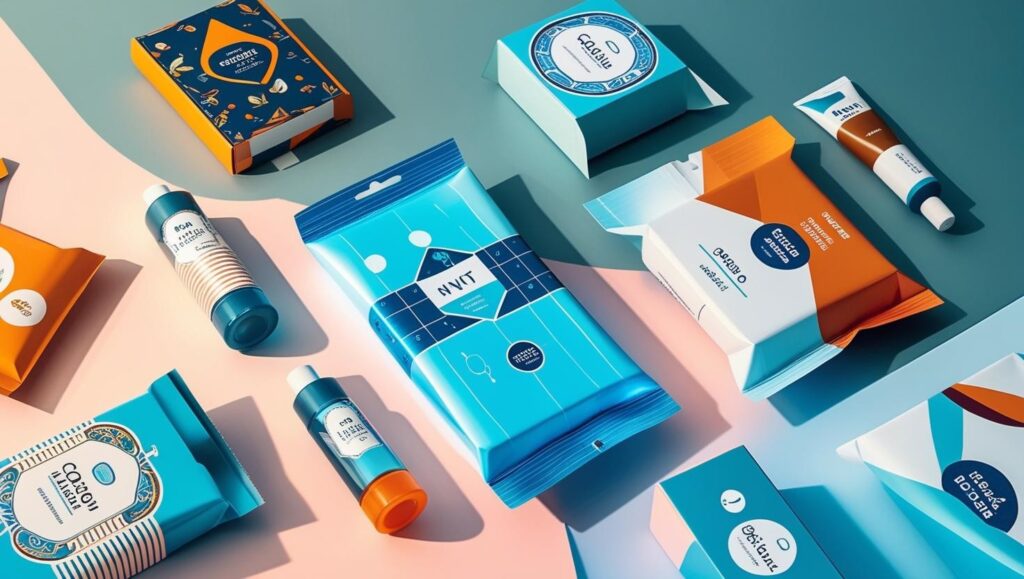Product packaging is more than just a protective cover; it’s a powerful marketing tool that reflects your brand and attracts customers. However, designing eye-catching packaging traditionally can be time-consuming and expensive. AI-powered design tools are changing the game by allowing businesses to create professional, custom packaging in just minutes.
In this blog, we’ll explore how AI can help you design unique, attractive product packaging quickly, affordably, and without the need for professional design skills.
The Challenge: Traditional Packaging Design vs. AI-Powered Tools
1. Traditional Packaging Design: Time-Consuming and Expensive
The traditional process of designing product packaging often requires collaboration with professional designers or agencies. While this can result in a high-quality, unique design, it also comes with significant challenges:
- Time-Consuming: The process can take weeks, especially when working through multiple revisions, and may require several rounds of feedback to reach a final design.
- High Costs: Professional designers or agencies can be expensive, making custom packaging out of reach for startups or small businesses.
- Limited Customisation: Depending on the designer’s interpretation, the final design may not fully align with the business’s vision, resulting in additional costs and time to make adjustments.
For many businesses, the cost and time required for traditional packaging design can make the process frustrating and inefficient.
2. AI-Powered Tools: Fast, Affordable, and Customisable
AI-powered packaging design tools are revolutionising how businesses approach the design process. By automating much of the creative process, AI provides several key advantages:
- Speed: AI tools generate multiple design options in minutes, drastically reducing the time it takes to create a product packaging design.
- Cost-Effectiveness: Compared to hiring a professional designer or agency, AI-powered tools are highly affordable, making them accessible to businesses of all sizes.
- Customisation: AI tools allow for extensive customisation of design elements, from colours and fonts to icons and layouts, enabling businesses to get exactly what they want without relying on a designer’s interpretation.
While AI tools may not offer the same level of creative intuition that a designer provides, they deliver a highly efficient and cost-effective solution for businesses looking to create professional product packaging quickly.
Traditional Packaging Design vs. AI-Powered Packaging Design
| Metric | Traditional Design | AI-Powered Design |
| Time to Design | Weeks | Minutes |
| Cost per Design | High | Low |
| Customisation | Limited | Extensive |
| Professional Quality | High (with designer) | High (AI-generated) |
| Scalability | Low | High |
How AI Can Help You Design Eye-Catching Product Packaging in Minutes
AI-powered tools have made designing eye-catching product packaging faster, more affordable, and highly customisable. With just a few inputs, businesses can create professional, tailored packaging that stands out on the shelf. Here’s how AI tools streamline the process:
1. Input Product Information and Preferences
The first step in using AI for packaging design is entering the product details and design preferences. You simply need to provide:
- Product name and type (e.g., skincare, food, electronics).
- Brand identity: Select design elements like colours, typography, and visual style (e.g., minimalist, vintage, modern).
- Target audience: Indicate the demographic the product is aimed at (e.g., children, adults, eco-conscious consumers).
With just these details, the AI system is able to begin designing packaging that aligns with your brand’s identity.
2. AI Packaging Design Generation
Once the information is provided, AI tools use advanced machine learning and design algorithms to generate multiple packaging design options. The AI analyses your inputs and creates several variations based on the following:
- Visual Elements: The AI applies colour theory, typography, and appropriate iconography based on your product’s industry.
- Brand Identity: The AI ensures the design reflects your brand values and target audience while adhering to common industry standards.
The AI tools generate several unique packaging designs in minutes, offering you a choice of styles and layouts.
3. Customisation and Refinement
After the AI generates multiple options, you can refine the design to meet your preferences. Customisation includes:
- Adjusting colours: Pick the colour palette that resonates with your brand.
- Changing fonts: Choose typography that complements the product’s image.
- Modifying icons and graphics: If the AI’s choice of symbols or imagery doesn’t align with your vision, you can easily swap them out.
The customisation process allows you to personalise the design to ensure it reflects your brand’s personality.
4. Final Selection and Download
Once you’re happy with the design, you can select your final logo and packaging design. AI tools allow you to download the logo and packaging in various file formats, such as PNG, SVG, or JPEG, ready for print or digital use.
- Example: A new skincare brand uses an AI tool to design elegant, minimalist packaging. In just 10 minutes, the design is created, refined, and ready for use across multiple product lines.
The Framework: How AI Designs Eye-Catching Product Packaging in Minutes
AI-powered product packaging tools are designed to make the process of creating packaging both quick and affordable while ensuring the final result is high quality and on-brand. Here’s a breakdown of the framework that AI follows to design eye-catching product packaging in just minutes.
1. Input Product Information and Brand Preferences
The first step is to provide the AI tool with essential product information and branding preferences. This includes:
- Product Details: Product name, type, and target market.
- Design Preferences: Colour scheme, style (e.g., minimalist, modern), font style, and imagery.
This simple input ensures that the AI understands the key factors that define your product and brand. The more specific the input, the better the AI can tailor the design to suit your needs.
2. AI Packaging Design Generation
Once the information is entered, the AI tool immediately begins generating multiple packaging designs. It takes into account several key factors:
- Typography: The AI chooses fonts that best reflect your brand identity and product category.
- Colours: The AI applies colour theory to select hues that align with your brand’s tone and market appeal.
- Graphics and Icons: AI integrates appropriate symbols and icons based on the product type (e.g., eco-friendly symbols for sustainable products or vibrant, playful icons for kids’ products).
AI generates several design variations, each with a unique style, layout, and branding focus, ready for you to review and choose from.
3. Customisation and Refinement
Once the AI generates the initial designs, the user can customise and refine the selected packaging design:
- Adjust Colours: Choose the specific colours that best fit the product or seasonal campaign.
- Change Fonts: Swap out fonts to reflect your brand’s visual identity.
- Modify Icons and Layouts: You can adjust placement or replace icons to ensure they align with your brand message and consumer expectations.
This customisation phase ensures that the AI-generated design meets your exact specifications.
4. Final Selection and Download
After customising the logo and packaging design to your satisfaction, the AI tool allows you to finalise your design and download it in various formats (e.g., SVG, PNG, JPEG). The tool also ensures the file is ready for high-quality printing or digital applications.
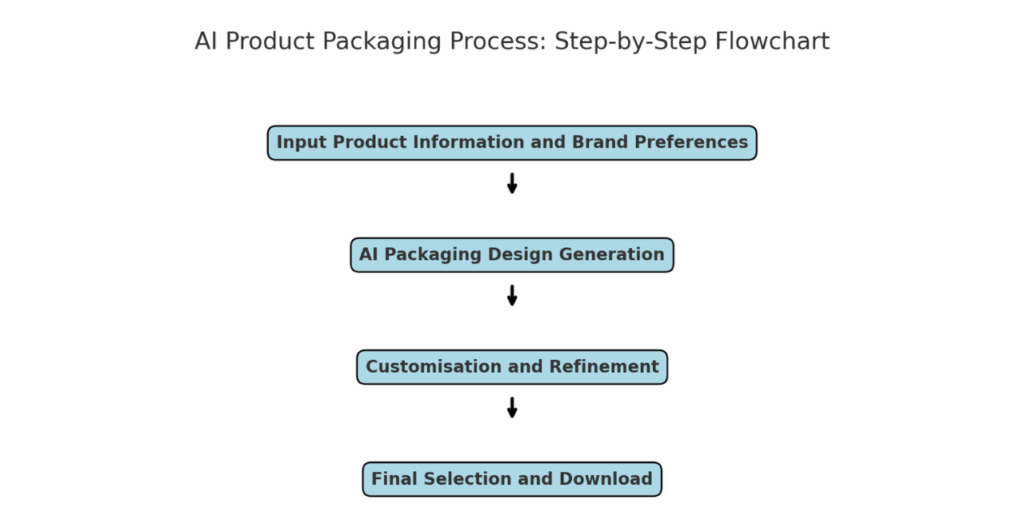
Real-World Applications: How Businesses Use AI for Product Packaging Design
AI-powered product packaging design tools have already proven their value in various industries by enabling businesses to create professional packaging quickly, affordably, and with a high degree of customisation. From startups to large enterprises, companies are adopting AI tools to streamline packaging design, ensuring consistency, speed, and scalability. Below are a few real-world applications of AI-driven packaging design.
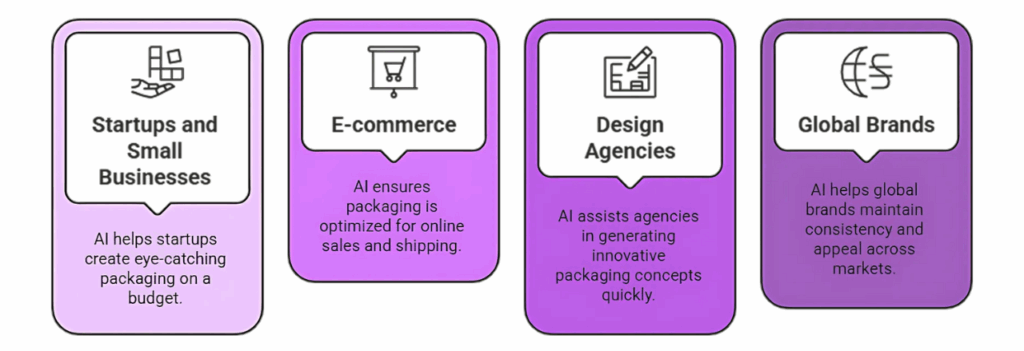
Startups and Small Businesses: Cost-Effective Branding
For startups and small businesses, AI tools provide an affordable way to create professional, custom packaging without the need for expensive designers or agencies. This is especially important for businesses with limited budgets and fast-paced timelines.
Example: A new organic skincare brand uses AI to design eco-friendly packaging with natural colours and minimalist fonts. The business is able to create and print the packaging within hours, giving it a strong professional look without the hefty cost of hiring a designer.
E-commerce: Scalable Packaging for Multiple Product Lines
For e-commerce brands, especially those that offer multiple products or variations, AI tools allow them to scale their packaging design efforts. The ability to quickly create and modify packaging designs for a wide range of products allows e-commerce companies to maintain brand consistency across their entire product range.
Example: A fashion retailer uses AI to design packaging for their seasonal collections. With the AI tool, they can quickly modify the designs based on the collection’s theme, ensuring that all packaging aligns with the brand’s aesthetic and seasonal messaging.
Design Agencies: Speeding Up Client Projects
Design agencies can leverage AI-powered tools to accelerate the packaging design process for their clients, particularly for small-scale projects or when clients need multiple design options to choose from. This not only increases the speed of delivery but also provides a high level of customisation.
Example: A design agency working with a new food product client uses AI to generate different packaging options based on the client’s preferences. After a quick review, the client selects the final design, and the agency customises it further, providing a professional look without the lengthy back-and-forth process.
Global Brands: Consistent Design Across Markets
Large-scale brands and global companies can use AI to maintain consistent product packaging across multiple regions while allowing for local customisations. AI helps create variations of the packaging design that align with local preferences or regulations without deviating from the core brand identity.
Example: A global beverage company uses AI to design packaging for their products across different markets. While the packaging maintains a consistent brand identity, AI tools allow for small adjustments to suit local languages, imagery, or regulatory requirements, enabling the brand to scale quickly in various countries.
Key Benefits of Using AI for Product Packaging Design
AI-powered product packaging design tools are transforming the way businesses approach packaging, offering numerous benefits that help enhance efficiency, reduce costs, and improve design quality. By automating and streamlining the process, AI makes it easier for businesses of all sizes to create eye-catching, functional packaging that aligns with their brand identity. Here are the key benefits of using AI for product packaging design:
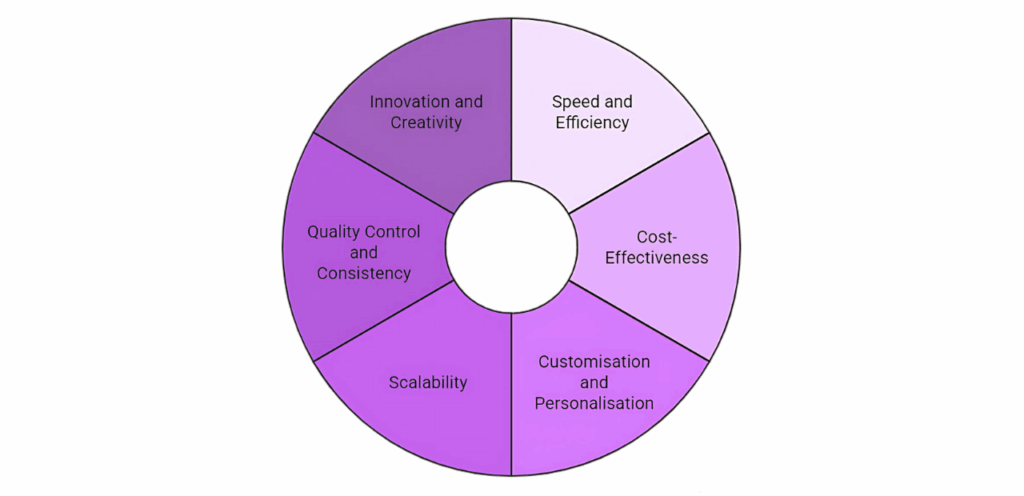
1. Speed and Efficiency
One of the most significant advantages of using AI for packaging design is the speed at which businesses can generate high-quality packaging. While traditional design methods often involve multiple rounds of revisions and time-consuming back-and-forth with designers, AI tools can produce several design options in minutes. This allows businesses to quickly iterate and select the best option without delays.
Example: A company launching a new product can use AI to create multiple packaging designs in under 10 minutes, enabling them to move forward with production much faster than waiting for traditional design cycles.
2. Cost-Effectiveness
AI-powered design tools offer a cost-effective solution for businesses, particularly for those with limited budgets or small product lines. Traditional design work often requires hiring a professional designer or design agency, which can be expensive. With AI tools, businesses can generate professional-level packaging designs at a fraction of the cost.
Example: A small business can create custom packaging for its products for as little as $20–$50 using an AI tool, compared to the $500–$2,000 it might spend on a freelance designer.
3. Customisation and Personalisation
AI tools offer high levels of customisation in the design process, allowing businesses to refine the design to suit their specific brand identity and product needs. From adjusting colours and fonts to modifying graphics and logos, AI tools offer a wide range of design options and allow for easy changes to ensure the packaging reflects the business’s vision.
Example: A brand can choose from multiple logo placements, typography styles, and colour palettes, making the packaging truly unique to the product.
4. Scalability
AI tools can scale the packaging design process across multiple product lines, regions, or even markets. Once a design is created, it can be adapted quickly for different products, sizes, or variations. AI ensures that design consistency is maintained across all packaging while allowing for localisation to meet regional preferences or legal requirements.
Example: A global beverage company can use AI to quickly generate packaging variations for different countries, ensuring the branding stays consistent while accommodating local language or legal requirements.
5. Quality Control and Consistency
AI tools are designed to maintain a high standard of quality and ensure that every logo, font, and colour scheme is accurately applied. The consistency of AI-generated packaging ensures that the final product reflects a professional and cohesive brand image across all packaging materials.
Example: AI ensures that the font and logo placement are consistent across different product lines, maintaining brand identity and professionalism throughout the packaging.
6. Innovation and Creativity
AI tools use advanced algorithms to generate creative packaging options that might not be considered during traditional design processes. By offering diverse design options and design combinations, AI allows businesses to explore new creative possibilities while ensuring the designs still meet branding standards.
Example: A company can experiment with bold colour combinations or new design styles without the need for a professional designer’s input.
Critical Considerations When Using AI for Product Packaging Design
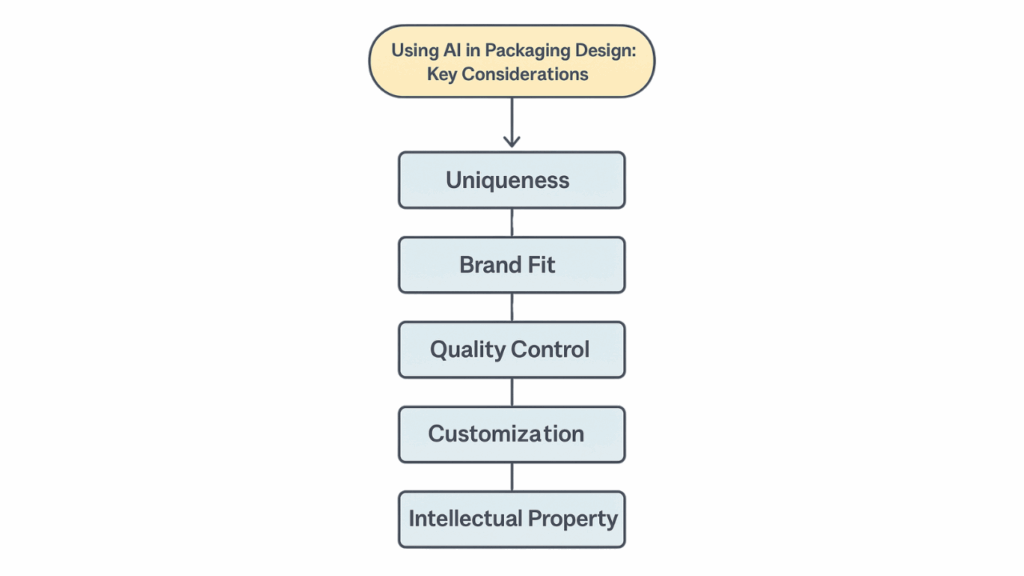
While AI-powered packaging design tools offer numerous advantages, businesses must consider certain factors to ensure that the designs are both effective and aligned with their branding goals. Here are some critical considerations when using AI for product packaging design:
1. Uniqueness and Originality
AI tools are based on templates and algorithms, which means that some designs generated by the AI may be similar to other logos or packaging created using the same tool. To ensure that your design is unique, businesses need to focus on customising the AI-generated options extensively. This includes tweaking colours, fonts, and design elements to create a design that truly reflects the brand.
Action Point: Take time to personalise the designs by adjusting every element, and consider combining different templates to create a one-of-a-kind design that stands out in the market.
2. Brand Fit and Consistency
Your product packaging should align with your brand identity and convey the right message to your customers. While AI tools are great at generating designs quickly, businesses must ensure that the final product resonates with their brand values, target audience, and product positioning.
Action Point: Carefully review AI-generated designs to ensure that the packaging aligns with your brand aesthetics and messaging. Pay attention to how the design reflects your brand’s personality (e.g., professional, playful, elegant) and ensure consistency with existing branding.
3. Quality Control
While AI can create designs quickly, the final product must be of high quality and suitable for print and digital platforms. Some designs may look great on-screen but fail to translate well to physical packaging materials, such as labels, boxes, or bags.
Action Point: After selecting a design, test it by printing mock-ups to ensure that the packaging maintains its integrity and looks professional when produced in bulk. Make sure that fonts are legible, colours are accurate, and the overall design is well-executed.
4. Customisation Limitations
AI tools offer a high degree of customisation, but they may not always match the level of creativity that a professional designer could offer. While AI tools generate multiple options quickly, there may still be limitations in terms of design complexity and abstract creative concepts.
Action Point: Use AI for initial logo and packaging generation, but don’t hesitate to consult with a professional designer if you need a more complex design or if the AI-generated designs don’t fully capture your brand’s vision.
5. Intellectual Property and Copyright
When using AI tools, there is the potential for copyright infringement if the design too closely resembles a logo or packaging created by another brand. This can especially be the case if the AI tool uses pre-existing templates or elements that are not exclusive to your design.
Action Point: Ensure that the AI tool you use offers exclusive rights to the generated designs and does not create content that could infringe on existing trademarks or copyrights. Consider conducting a trademark search to avoid legal issues down the line.
Conclusion: The Future of Product Packaging Design with AI
AI-powered packaging design tools are changing the way businesses approach product packaging, offering speed, cost-efficiency, and customisation that were once impossible with traditional design methods. These tools make professional design accessible to businesses of all sizes, from startups to global brands. As AI continues to evolve, the possibilities for creating eye-catching and innovative packaging are limitless.
Ready to create your unique packaging in minutes? Start using AI today and give your product the professional look it deserves. Get in touch with us.
